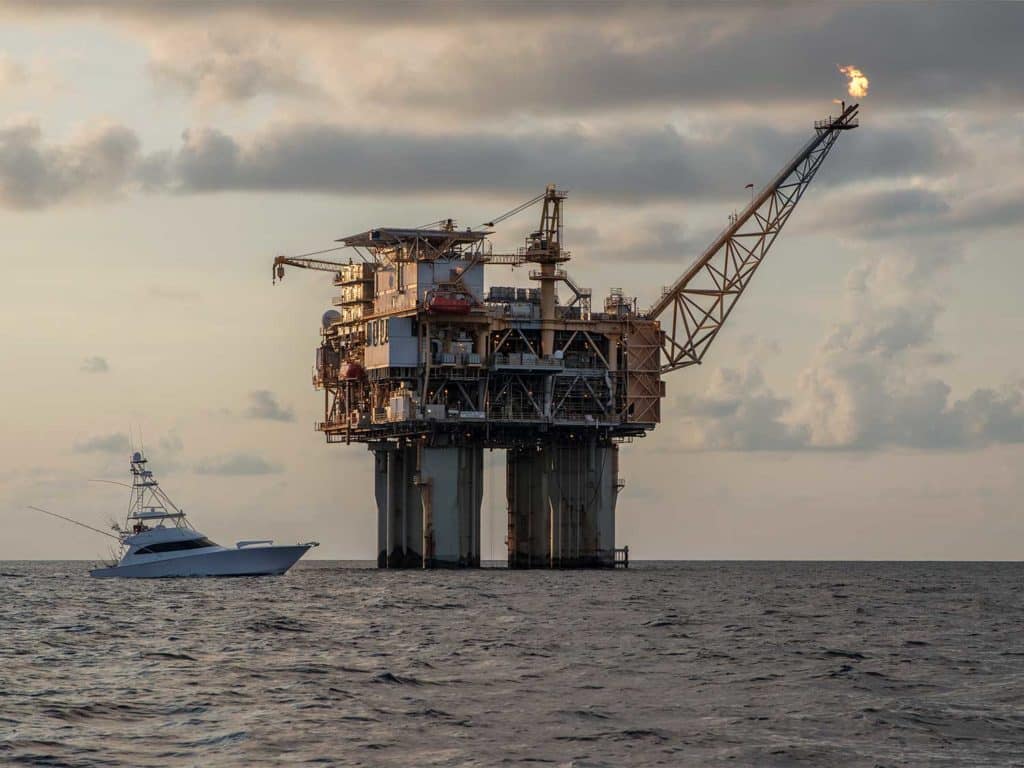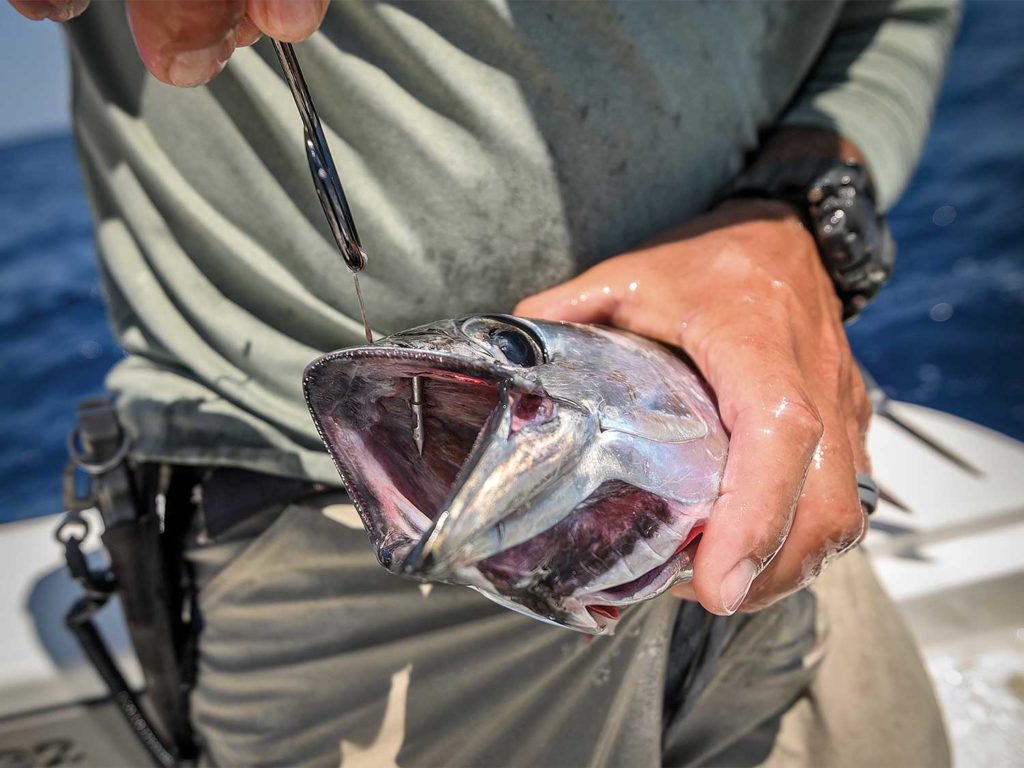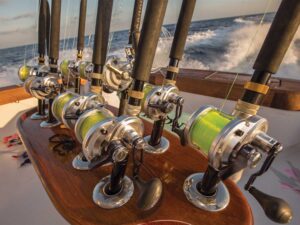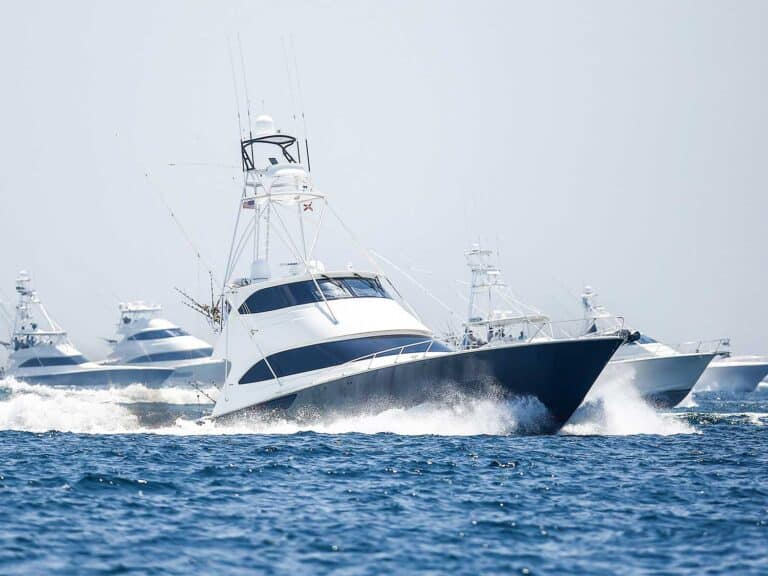
If there is one thing I’ve learned from the live-bait guys in South Florida, it’s the importance of keeping your bait healthy. No matter what species you are fishing for, or what method you use, the bait is what will make or break your day. And if you want to catch a winning fish off a Gulf of Mexico drilling rig, then you’d better be sure your ducks are in a row. From the rig you choose to fish to the way you handle the bait, your finicky 800-pounder sure knows if it’s worth the calories spent on chasing it.
We sometimes travel hundreds of miles in search of the best conditions, so you should know where you are going before you leave the slip. Offshore-conditions-reporting services and a professional network of captains are two things I use to help determine my final destination. With so many rigs to fish, you can easily narrow down your options by making an educated and informed decision.
My trusted network not only contains my friends, it also includes my competitors. We have an understanding: We do it for the greater good—our bosses—so it motivates us all to work together to find a solid area that hopefully produces bites.
The Bait
One of my mentors once told me, “Your bait is more important than your location,” and this is true—because after all that running, sometimes you’ll just have to pound it out. And a lot of the time, the right bait will make it happen for you.
No doubt my favorite live bait for blues are small yellowfin tuna. They are hardy, very strong, and they like to swim down. They also get bit more than any other bait I’ve used. Sure, blackfins are eaten by marlin all the time in the wild, but put them on a hook and they get lazy; they’re good for a minute or two, then they get tired. Blue marlin will eat them, but I have found yellowfins to be the superior bait—and most of my big tournament fish have been caught on yellowfins.
To start making bait, I drive around until I mark it. Most of the time it will be on the up-current side of the rig about 60 or so yards from it. I find the small tunas bite best at night and I give myself plenty of time to get the highest-quality baits. With a good jig rod and a high-speed conventional reel loaded with 80-pound braid, I use vertical jigs to reach them anywhere from 60 to 250 feet down. The key is to get each bait in the boat as soon as possible to keep it away from predators.
Depending on the class of fish you’re after, the baits should be anywhere from 5 to 10 pounds. If you’re fishing for numbers, stay closer to the 5-pound range, but if you’re fishing for a tournament winner, then the 10-pounders are a good bet. Any baits larger than 12 pounds makes it harder to get the bait turned around in the marlin’s gullet and ultimately hook the fish. A rubber-coated dip net is held under each bait as it is removed from the hook, then its eyes are covered as we set it gently into the tuna tube. I load my 16 tubes and then catch two more: these two are the ones I will start fishing with.

The Setout
I always try to be where I want to fish during the majors and minors of the moon cycles. In the major periods, the moon is directly overhead or directly below a reference of longitude. Conversely, the minors occur when the moon is positioned at 90 degrees to either side. I have found these times to be the best to fish for bait—and blue marlin—in my neck of the woods. If you’re driving around and still looking during the bite, you’re messing up.
My setup will depend on the number of boats I’m fishing around as well as the time of the season. I start with 130-pound outfits—28-foot 220- to 300-pound-test fluorocarbon leader, crimped to a high-quality ball-bearing swivel; a mainline Benjamin (St. Thomas) knot to the ball-bearing swivel; and a Mustad 12/0 to 20/0 circle hook, crimped directly to the leader—but will scale down as more boats start fishing the same rig. Your hook size should be matched to the bait.
I fish 200 yards up-current of the rig, fishing only two rods at a time. Instead of bridling the baits the conventional way, Team Supreme uses the Bridle-Buddy: a small dart that pivots 90 degrees and locks into place on the roof of the bait’s mouth, saving not only handling time, but damage to the bait itself. A specialized tool is used to insert the dart that is attached to your Dacron-bridled hook. It is a natural presentation that increases your bait’s longevity and food-appeal, which increases your hook-up ratio.
After you’ve bridled your first tuna, set it in the water gently—never slap or throw your bait in the water—and run the rigger pin up, letting it go out approximately 40 arm lengths. Do the same for the second bait, letting it out approximately 25 arm lengths; this is your short rigger.
You can tell a lot about what is going on by watching your rigger pins. As the bait swims around, a violent shaking of the pin lets you know something is checking it out—it will start to freak out and come to the surface—and it’s getting ready to be chomped.
The Bite
Once you’re bit, the bump, bump, bump will change to a slow pull. Try to feed it through the rigger pin while the other guy clears his bait from the spread. Clearing the other bait immediately will keep your fish from trying to eat it as soon as it has swallowed the first one.
The aggressiveness of the bite and the size of the bait will determine your feed time, and it doesn’t take long for a big blue to wolf down a small tuna. I try to keep the boat at an angle and close to the bite, because once the fish feels the pressure of the angler starting to reel, it sometimes will turn on you. With the boat in gear, slowly turn the handle to ease yourself tight. A slow, even-pressured pull with minimal drag will set a circle hook, so there is no need to jam the boat into gear—if the fish has it, the fish has it.
The Gulf is full of obstacles—other boats, the rig, crew boats—so be aware of your surroundings and be sure when you set out, you’re on the up-current side; I’ve found the fish most always run that direction. Maneuver the boat so that no matter what happens, you will be able to change your position. You only can control what the boat does, not what the fish does, so by using good judgement and keeping your angles, entanglement is much less likely to happen.







